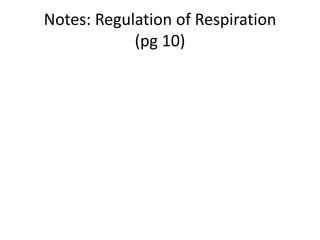
Regulation of respiration
- 1. Notes: Regulation of Respiration (pg 10)
- 2. Respiratory Center • Group of neurons in the pons and medulla oblongata that control the rate and depth of breathing
- 3. Respiratory Center • Group of neurons in the pons and medulla oblongata that control the rate and depth of breathing • Inspiratory area sends impulses to the diaphragm and, for deeper breathing, to the external intercostal muscles. Muscles contract and inspiration occurs
- 4. Respiratory Center • Group of neurons in the pons and medulla oblongata that control the rate and depth of breathing • Inspiratory area sends impulses to the diaphragm and, for deeper breathing, to the external intercostal muscles. Muscles contract and inspiration occurs • Nerves fatigue quickly and stop sending impulses. Muscles then relax and expiration occurs. When forceful expiration is necessary, expiratory area sends impulses to the internal intercostal muscles
- 5. Output (pg 11) • Paste in oval diagram • Color code: Red for inspiration, blue for expiration
- 6. Chemoreceptors • Receptors in the medulla oblongata that are sensitive to changes in CO2 and H+ (acidity) levels
- 7. Chemoreceptors • Receptors in the medulla oblongata that are sensitive to changes in CO2 and H+ (acidity) levels • If CO2 and H+ levels increase, the chemoreceptors stimulate the respiratory center to increase the rate and depth of breathing
- 8. Chemoreceptors • Receptors in the medulla oblongata that are sensitive to changes in CO2 and H+ (acidity) levels • If CO2 and H+ levels increase, the chemoreceptors stimulate the respiratory center to increase the rate and depth of breathing • Receptors sensitive to oxygen levels are located in the aorta. However, low oxygen level is not as strong a stimulus for breathing as high CO2 level.
- 9. Stretch Receptors • As alveoli in the lungs expand, stretch receptors are stimulated
- 10. Stretch Receptors • As alveoli in the lungs expand, stretch receptors are stimulated • Stretch receptors initiate the Hering-Breuer reflex, which prevents overinflation of the lungs. Impulses travel to medulla oblongata where they inhibit the inspiratory neurons.
- 11. Stimulus from higher brain centers • Impulses from higher brain can temporarily override the respiratory center.
- 12. Stimulus from higher brain centers • Impulses from higher brain can temporarily override the respiratory center. • Impulses may be voluntary (singing, holding your breath) or involuntary (emotions, sudden pain or cold)
- 13. Stimulus from higher brain centers • Impulses from higher brain can temporarily override the respiratory center. • Impulses may be voluntary (singing, holding your breath) or involuntary (emotions, sudden pain or cold) • When CO2 levels reach a critical point, impulses from the higher brain centers are ignored and the respiratory center resumes control
- 14. Temperature • Increase in body temperature causes increase in breathing rate.
- 15. Temperature • Increase in body temperature causes increase in breathing rate. • Higher temperature leads to higher metabolism and more CO2 production
- 16. Respiratory Volumes • Tidal Volume (TV): ≈ 500 ml. Amount of air inhaled and exhaled during normal quiet breathing
- 17. Respiratory Volumes • Tidal Volume (TV): ≈ 500 ml. Amount of air inhaled and exhaled during normal quiet breathing • Inspiratory Reserve Volume (IRV): ≈ 3100 ml. Maximum amount of air that can be forcefully inhaled after a normal exhale
- 18. Respiratory Volumes • Tidal Volume (TV): ≈ 500 ml. Amount of air inhaled and exhaled during normal quiet breathing • Inspiratory Reserve Volume (IRV): ≈ 3100 ml. Maximum amount of air that can be forcefully inhaled after a normal exhale • Expiratory Reserve Volume (ERV): ≈ 1200 ml. Maximum amount of air that can be forcefully exhaled after a normal inhale
- 19. Respiratory Volumes • Tidal Volume (TV): ≈ 500 ml. Amount of air inhaled and exhaled during normal quiet breathing • Inspiratory Reserve Volume (IRV): ≈ 3100 ml. Maximum amount of air that can be forcefully inhaled after a normal exhale • Expiratory Reserve Volume (ERV): ≈ 1200 ml. Maximum amount of air that can be forcefully exhaled after a normal inhale • Residual Volume (RV): ≈ 1200 ml. Amount of air that remains in the lungs after maximum expiration
- 20. Respiratory Capacities • Vital capacity = TV + IRV + ERV. Maximum amount of air that can be exhaled after a maximum inspiration
- 21. Respiratory Capacities • Vital capacity = TV + IRV + ERV. Maximum amount of air that can be exhaled after a maximum inspiration • Total lung capacity = TV + IRV + ERV + RV. Amount of air in the lungs after a maximum inspiration
- 22. Output (pg 11) • Label diagram